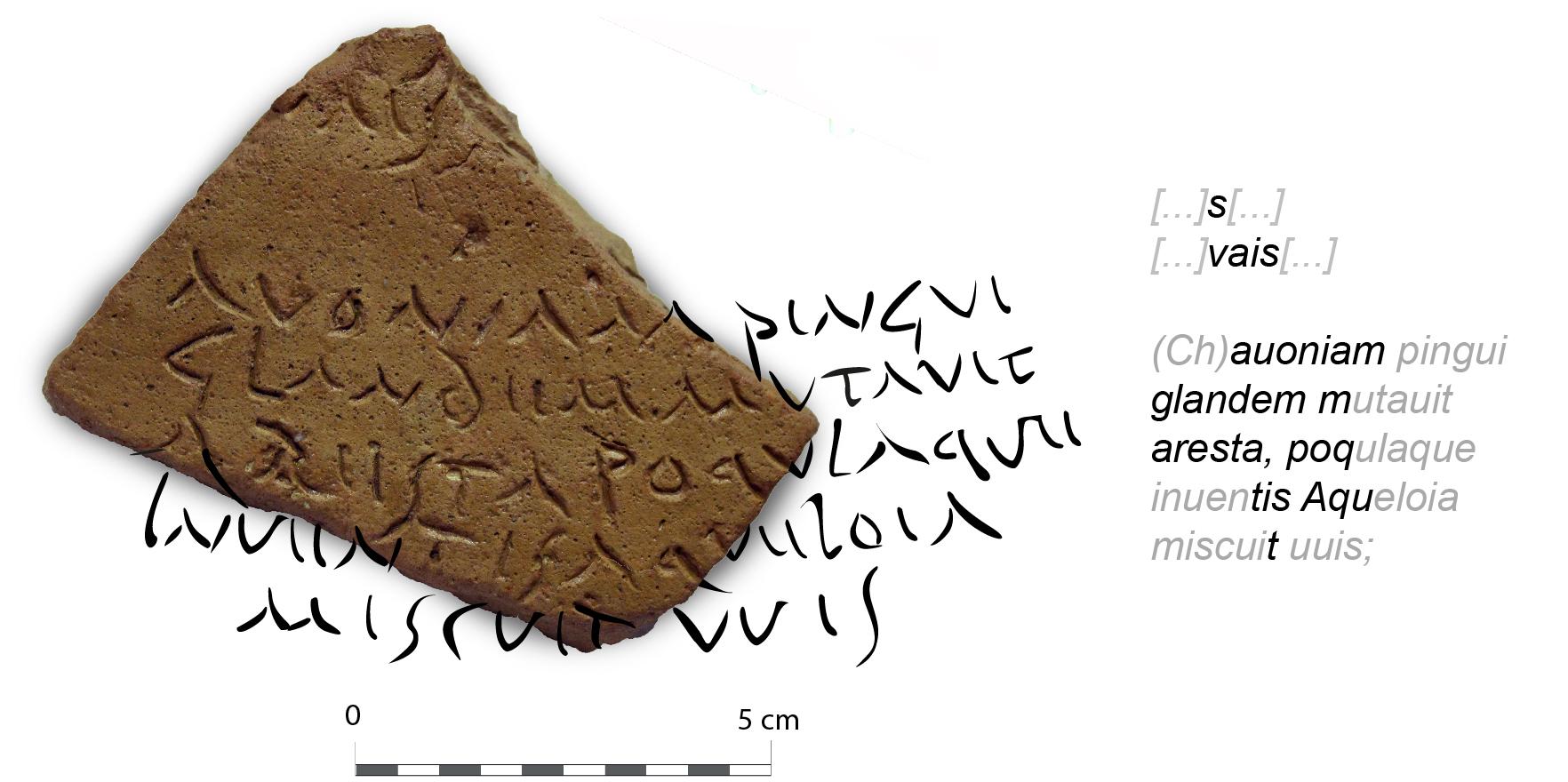Virgil's Verses Found On Ancient Olive Oil Vessel
A fragment of literature was found by accident in a pile of broken pottery.

Measuring just 6 centimeters wide and 8 long, the magnitude and exceptionality of the discovery has left the European archaeological community flabbergasted. It is a fragment of an oil amphora from the Roman region of Hispania Baetica, manufactured about 1,800 years ago, with a written text on it, found during prospecting carried out in the municipality of Hornachuelos (Córdoba) in Spain by members of OLEASTRO, a joint project conducted by the Universities of Cordoba, Seville and Montpellier.
Ancient Hispania Baetica was one of three Roman provinces of the Iberian Peninsula. It was bordered on the west by Lusitania (modern Portugal), and to the northeast by Hispania Tarraconensis. Hispania Baetica remained one of the basic divisions of Hispania under the Visigoths and invasions by Vandals down to 711 AD. It is now part of Andalucia -- a deformation of 'Vandal'. Following the Muslim invasion of 711 AD, it was under Islamic rule for centuries until 1236, when Christians overpowered the Muslims.
Thus far, nothing would have been extraordinary about the find, as countless pieces of pottery from ancient Rome have been found. Monte Testaccio in Rome, an artificial mound comprised of Roman pottery, is an infinite source of information about the Roman olive and wine industry. In fact, at first, the research team was not particularly surprised to receive the fragment from Francisco Adame, a resident of the village of Ochavillo, the first person who noticed that little piece of Rome when walking through Arroyo de Tamujar, an area very close to the village of Villalón (Fuente Palmera).
Neither was the research team astonished by the fact that the amphora featured words, as this is quite common too. In fact, the information printed on amphorae, such as producers' names, quantities, and quality controlhas allowed archaeologists to understand the history of agricultural trade during the Empire.
Likewise, it was hardly shocking to find a piece of an amphora in an area like the plain of the Guadalquivir River, considered one of the nerve centers of olive oil production and trade throughout the Empire. In the surroundings of Corduba, modern-day Cordoba, a good part of the olive oil consumed by Rome was produced and packaged, as evidenced, for example, by the remnants of amphorae with "Betica" seals preserved on Mount Testaccio.
Cordoba remains a center of olive oil production. Some producers, such as Estrella del Guadalquivir, have been in the business for centuries.
Thus, the fragment of an amphora with text on it seemed, at first, just another empty shard, devoid of special interest. Everything changed, however, when the epigraph was deciphered, revealing the following words
S
vais
avoniam
glandemm
arestapoqv
tisaqv
it
Through overlaying, the researchers were able to infer that the text corresponds to the seventh and eighth verses of the first book of The Georgics, a poem by Virgil dedicated to agriculture and life in the countryside, written in 29 BC, which say:
Auoniam[pingui]
glandem m[utauit]
aresta, poq[ulaque]
[inuen]tisAqu[eloia]
[miscu]it [uuis]
replaced Chaonian acorns,
and mixed Achelous’s water with newly-discovered wine,
Virgil was the most popular poet of his time, and still many centuries later. The Aeneid was taught at schools, and its verses routinely written as a pedagogical exercise for many generations. Thus, it is common to find them on the remains of ceramic construction materials, with many authors deducing that these tablets had educational functions (Roman schoolchildren wrote Virgil on their chalkboards) and funerary ones (Virgil's verses served as an epitaph on many occasions). But, why on an amphora?
And why The Georgics, and not The Aeneid? Posing these questions, the researchers on the project realized that the tiny fragment of pottery could be a unique piece, and one of extraordinary value, since Virgil's verses had never been documented on an amphora destined for the oil trade.
The authors' main thesis in the work, published in the Journal of Roman Archaeology (University of Cambridge), in which Dr. Iván González Tobar appears as principal investigator, who is currently a researcher at the University of Barcelona, and hired by the University of Montpellier when the piece was found, is that the verses were written on the underside of the amphora without anyone expected to notice them, only as a sign of the knowledge and culture of the person who wrote them, revealing a certain level of literacy in the fertile plain of the Guadalquivir area.
Who wrote it? Here, the authors posit several possibilities: that they were written by a specialized worker of the establishment with a certain degree of literacy, or someone from the nearby villages related to an aristocratic family owning the factory. They are also open to the possibility that a child worker wrote it, as the regular use of young workers at this type of establishment has been previously documented.
In any case, the verses on the amphora from Hornachuelos/Fuente Palmera make it a unique piece posing many more questions in need of answers.
Martin Barillas is a retired diplomat, and author of 'Shaken Earth', which is available at Amazon. Signed copies are available by writing martinbarillasdelapena@gmail.com